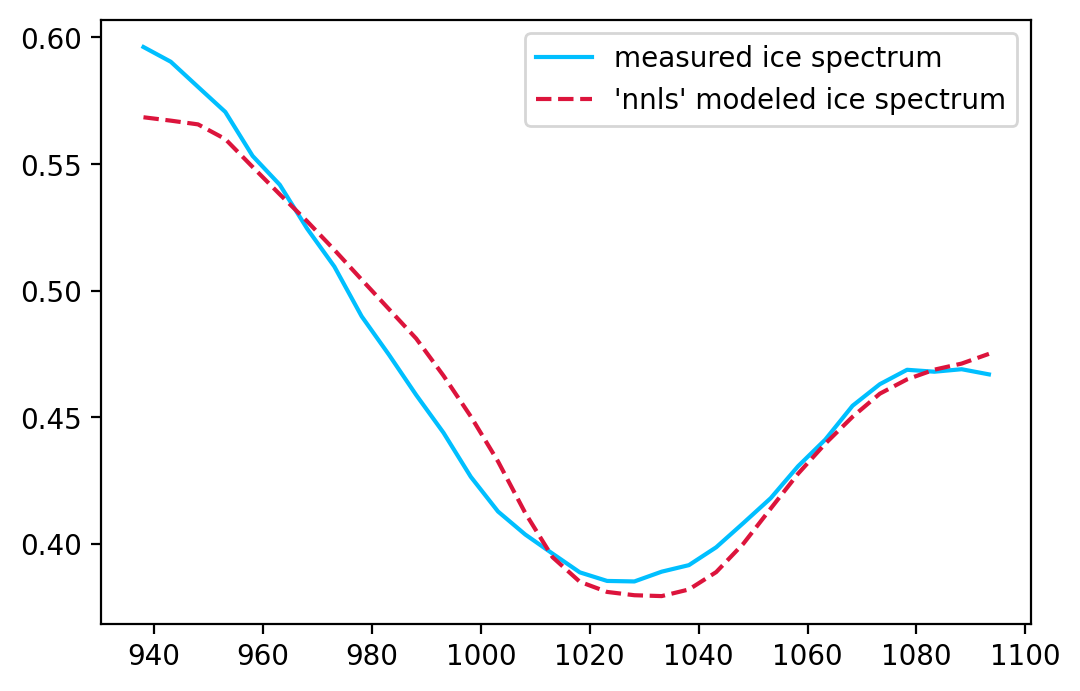Introduction to AVIRIS-NG
Contents
Introduction to AVIRIS-NG¶

Contributors: Joachim Meyer1, Chelsea Ackroyd1, McKenzie Skiles1
1University of Utah
Learning Objectives
Become familiar with hyperspectral data, including data orginiating from AVIRIS-NG
Understand the fundamental methods for displaying and exploring hyperspectral data in Python
Identify the amount of ice in a given pixel using spectral feature fitting methodology
Review of Hyperspectral Data¶
https://www.neonscience.org/resources/learning-hub/tutorials/hyper-spec-intro
Spectral Resolution¶
Incoming solar radiation is either reflected, absorbed, or transmitted (or a combination of all three) depending on the surface material. This spectral response allows us to identify varying surface types (e.g. vegetation, snow, water, etc.) in a remote sensing image. The spectral resolution, or the wavelength interval, determines the amount of detail recorded in the spectral response: finer spectral resolutions have bands with narrow wavelength intervals, while coarser spectral resolutions have bands with larger wavelength intervals, and therefore, less detail in the spectral response.
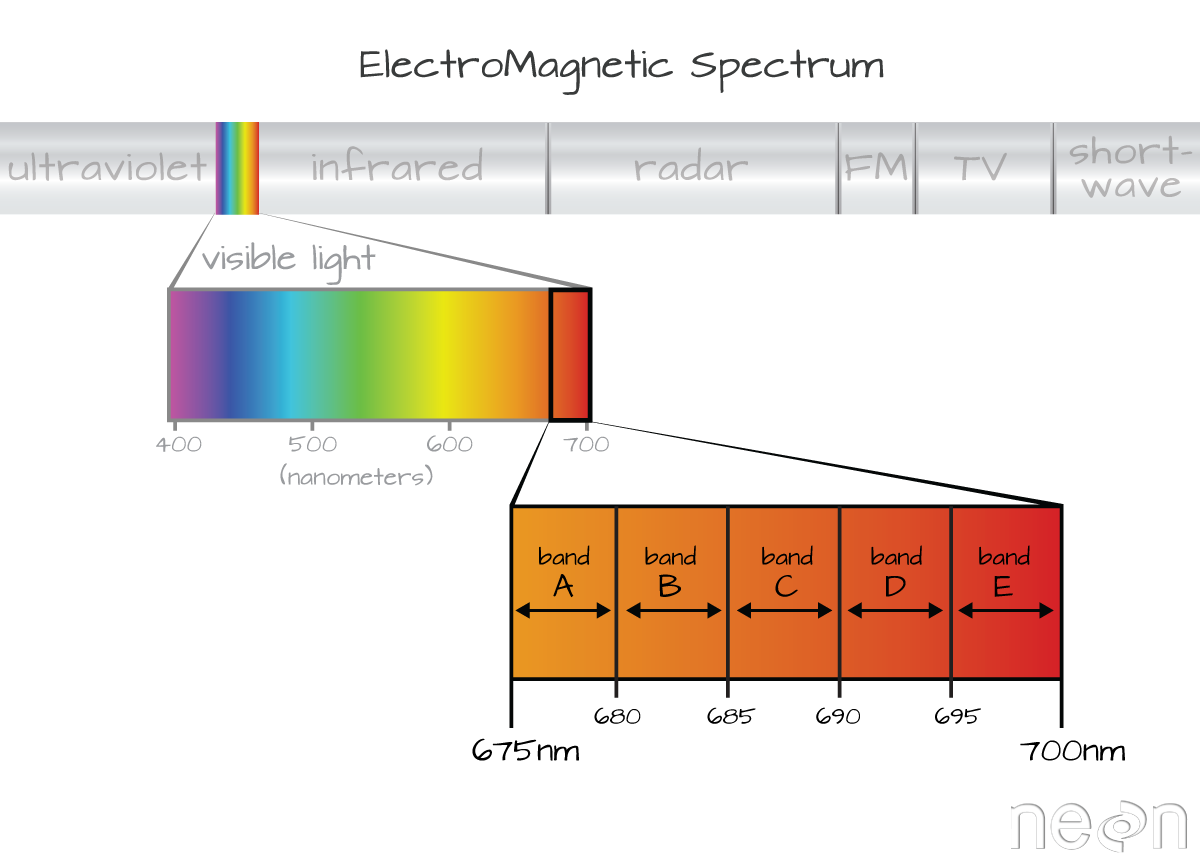
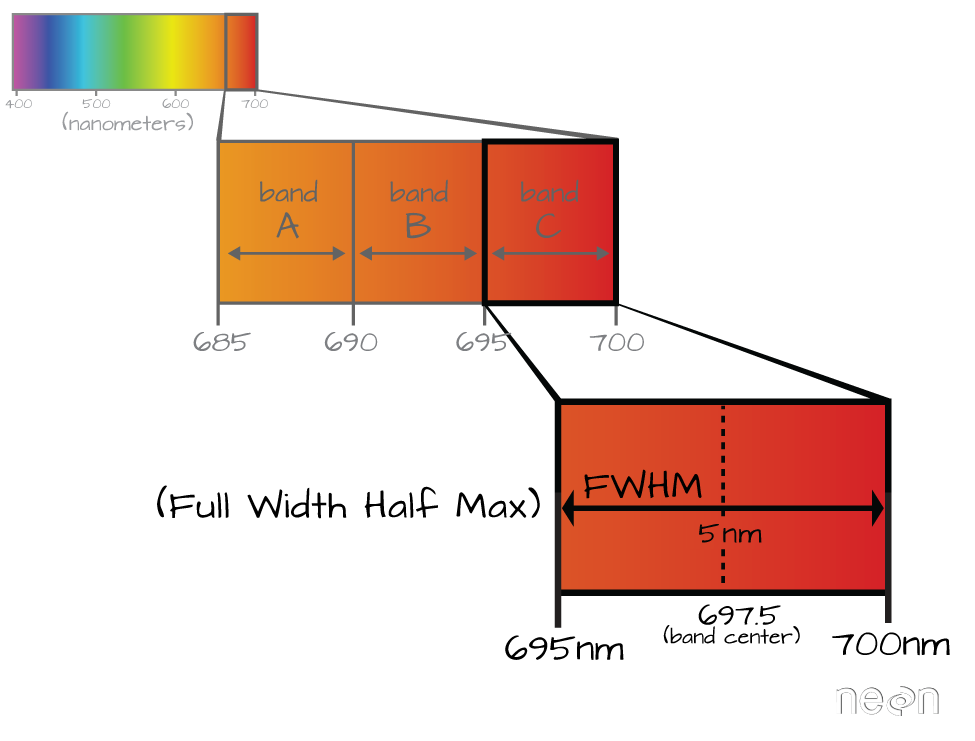
Multispectral vs. Hyperspectral Data¶
Multispectral instruments have larger spectral resolutions with fewer bands. This level of detail can be limiting in distinguishing between surface types. Hyperspectral instruments, in comparison, typically have hundreds of bands with relatively narrow wavelength intervals. The image below illustrates the difference in spectral responses between a multispectral (Landsat 8 OLI) and a hyperspectral (AVIRIS) sensor.
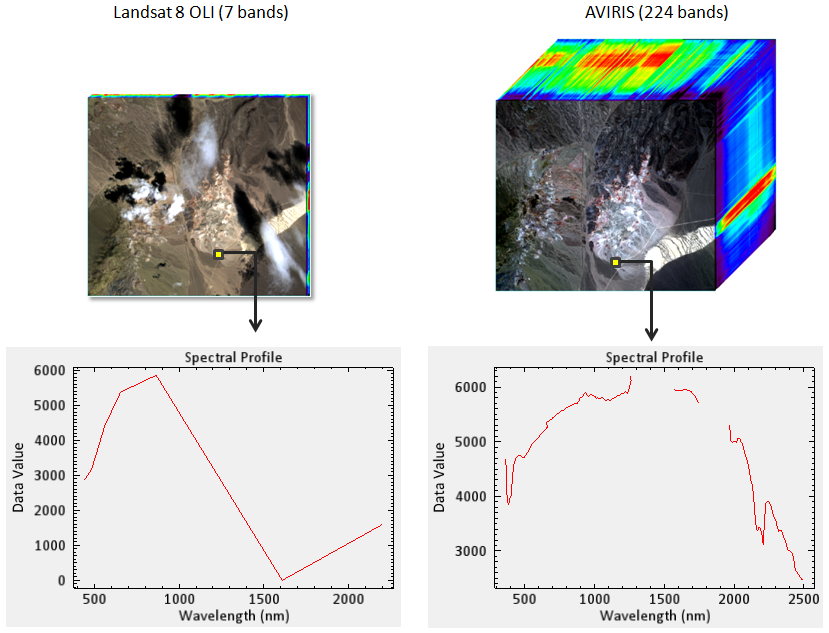
AVIRIS-NG Meets SnowEx¶
AVIRIS-NG measures upwelling radiance across 485 continuous spectral bands.
| Flight Altitude | Spatial Resolution | Spectral Resolution | Spectral Range | 2021 Flight Dates | Study Sites |
|---|---|---|---|---|---|
| 25,000 ft ASL | 4 m | 5 nm | 380 nm to 2510 nm | 03/19, 04/11, 04/29 | Senator Beck Basin; Grand Mesa Study Plot |
Where can I get the data?¶
NSIDC (Soon public)
Data products:
Spectral radiance/observation geometry (L1B)
Corrected Reflectance (L2)
First look at the data¶
Important
You will always want the data file and the header file when processing
For today, we are downloading and using a sub sample. The download is done via the Python urllib.request native library.
import urllib.request
The data file
SBB_data_file = 'data/ang20210411t181022_rfl_v2z1a_img_SASP'
urllib.request.urlretrieve(
'https://github.com/snowex-hackweek/tutorial-data/blob/main/SnowEx-2022/AVIRIS-NG/ang20210411t181022_rfl_v2z1a_img_SASP?raw=true',
SBB_data_file
);
The header file
SBB_header_file = 'data/ang20210411t181022_rfl_v2z1a_img_SASP.hdr'
urllib.request.urlretrieve(
'https://raw.githubusercontent.com/snowex-hackweek/tutorial-data/main/SnowEx-2022/AVIRIS-NG/ang20210411t181022_rfl_v2z1a_img_SASP.hdr',
SBB_header_file
);
The original header file (hold on tight on why …)
original_header_file = 'data/ang20210411t181022_rfl_v2z1a_img.hdr'
urllib.request.urlretrieve(
'https://raw.githubusercontent.com/snowex-hackweek/tutorial-data/main/SnowEx-2022/AVIRIS-NG/ang20210411t181022_rfl_v2z1a_img.hdr',
original_header_file
);
Exploring many flight lines¶
Interactive exploration using GeoPandas and the folium plotting library:
import geopandas
import folium
With a little help from GDAL, we can create an index for all flight lines and see where they are:
A example command that creates a GeoPackage
gdaltindex -t_srs EPSG:4326 index.gpkg ang20210411t1*_rfl*img
Breaking down the command:¶
This command creates an index file index.gpkg for all flightlines starting with ang20210411t1* and selects only the reflectance prodcuts _rfl*img. The star * acts as a wildcard to include more than one file where the elements of the string as whole matches. The -t_srs EPSG:4326 ensures that the read projection for all files will be stored as WGS 84 in the index. It does not change anything with the flight line data itself.
Specifically for hyperspectral data, it is important to not include the header files (ending with .hdr). GDAL automatically reads those with every image file and adding them to the list of files would cause a duplication.
One way to test the included files is to use the search string with the list (ls -l) command in the terminal.
The -l option lists the output with one line per file.
Example:
ls index.gpkg ang20210411t1*_rfl*img
Sample output:
-rw-r--r-- 1 username groupname 2438534400 Feb 16 08:23 ang20210411t180555_rfl_v2z1a_img
-rw-r--r-- 1 username groupname 1611382400 Feb 16 08:24 ang20210411t181022_rfl_v2z1a_img
-rw-r--r-- 1 username groupname 1980166800 Feb 16 08:23 ang20210411t181414_rfl_v2z1a_img
-rw-r--r-- 1 username groupname 1898560000 Feb 16 08:23 ang20210411t181822_rfl_v2z1a_img
-rw-r--r-- 1 username groupname 9076497200 Feb 16 08:23 ang20210411t184544_rfl_v2z1a_img
-rw-r--r-- 1 username groupname 8742760000 Feb 16 08:23 ang20210411t185350_rfl_v2z1a_img
-rw-r--r-- 1 username groupname 8283032400 Feb 16 08:23 ang20210411t191149_rfl_v2z1a_img
-rw-r--r-- 1 username groupname 8161863200 Feb 16 08:23 ang20210411t191954_rfl_v2z1a_img
Load the created index and some geo-spatial information into a Geo-Dataframe to explore interactively¶
GeoPandas has the ability to read files from disk or from a remote URL. When using a URL the information is held in memory for that session and will be lost once you restart the Python kernel.
flight_lines = geopandas.read_file('https://github.com/snowex-hackweek/tutorial-data/blob/main/SnowEx-2022/AVIRIS-NG/20210411_flights.gpkg?raw=true')
sbb = geopandas.read_file('https://raw.githubusercontent.com/snowex-hackweek/tutorial-data/main/SnowEx-2022/AVIRIS-NG/SBB_basin.geojson')
swamp_angel = geopandas.read_file('https://raw.githubusercontent.com/snowex-hackweek/tutorial-data/main/SnowEx-2022/AVIRIS-NG/SwampAngel.geojson')
# Create a map with multiple layers to explore where the lines are
## Layer 1 used as base layer
sbb_layer = sbb.explore(
name='SBB basin',
color='green'
)
## Layer 2
swamp_angel.explore(
m=sbb_layer, ## Add this layer to the Layer 1
name='Swamp Angel Study Plot'
)
## Layer 3
flight_lines.explore(
m=sbb_layer, ## Add this layer to the Layer 1
name='AVIRIS flight lines',
column='location'
)
# Top right box to toggle layer visibility
folium.LayerControl().add_to(sbb_layer)
# Show the final map with all layer
sbb_layer
Exploring a single flight line¶
Check our current file location (This is called a magic command)
%pwd
'/home/runner/work/website2022/website2022/book/tutorials/aviris-ng'
Which output we can store in a local variable
home_folder = %pwd
Create absolute paths to our downloaded files
SBB_data_file = f'{home_folder}/{SBB_data_file}'
SBB_header_file = f'{home_folder}/{SBB_header_file}'
Spectral Python library¶
import spectral
# Create a file object for the original image
image = spectral.open_image(SBB_header_file)
# Get information about the bands
image.bands.centers
Darn … we have an empty output. This subset was created using the GDAL library. Unfortunately, GDAL does not write the headers in a format that the spectral library recognizes. This is where the original header file comes into play.
import spectral.io.envi as envi
Attention
We are giving the original header, but the subset data file. It’s a workaround to get to the band information.
header = envi.open(original_header_file, SBB_data_file)
Find band index for a wavelength¶
import numpy as np
type(header.bands)
spectral.spectral.BandInfo
Ahhh … much better
bands = np.array(header.bands.centers)
bands
array([ 377.071821, 382.081821, 387.091821, 392.101821, 397.101821,
402.111821, 407.121821, 412.131821, 417.141821, 422.151821,
427.161821, 432.171821, 437.171821, 442.181821, 447.191821,
452.201821, 457.211821, 462.221821, 467.231821, 472.231821,
477.241821, 482.251821, 487.261821, 492.271821, 497.281821,
502.291821, 507.301821, 512.301821, 517.311821, 522.321821,
527.331821, 532.341821, 537.351821, 542.361821, 547.361821,
552.371821, 557.381821, 562.391821, 567.401821, 572.411821,
577.421821, 582.431821, 587.431821, 592.441821, 597.451821,
602.461821, 607.471821, 612.481821, 617.491821, 622.491821,
627.501821, 632.511821, 637.521821, 642.531821, 647.541821,
652.551821, 657.561821, 662.561821, 667.571821, 672.581821,
677.591821, 682.601821, 687.611821, 692.621821, 697.621821,
702.631821, 707.641821, 712.651821, 717.661821, 722.671821,
727.681821, 732.691821, 737.691821, 742.701821, 747.711821,
752.721821, 757.731821, 762.741821, 767.751821, 772.751821,
777.761821, 782.771821, 787.781821, 792.791821, 797.801821,
802.811821, 807.821821, 812.821821, 817.831821, 822.841821,
827.851821, 832.861821, 837.871821, 842.881821, 847.881821,
852.891821, 857.901821, 862.911821, 867.921821, 872.931821,
877.941821, 882.951821, 887.951821, 892.961821, 897.971821,
902.981821, 907.991821, 913.001821, 918.011821, 923.021821,
928.021821, 933.031821, 938.041821, 943.051821, 948.061821,
953.071821, 958.081821, 963.081821, 968.091821, 973.101821,
978.111821, 983.121821, 988.131821, 993.141821, 998.151821,
1003.151821, 1008.161821, 1013.171821, 1018.181821, 1023.191821,
1028.201821, 1033.211821, 1038.211821, 1043.221821, 1048.231821,
1053.241821, 1058.251821, 1063.261821, 1068.271821, 1073.281821,
1078.281821, 1083.291821, 1088.301821, 1093.311821, 1098.321821,
1103.331821, 1108.341821, 1113.341821, 1118.351821, 1123.361821,
1128.371821, 1133.381821, 1138.391821, 1143.401821, 1148.411821,
1153.411821, 1158.421821, 1163.431821, 1168.441821, 1173.451821,
1178.461821, 1183.471821, 1188.471821, 1193.481821, 1198.491821,
1203.501821, 1208.511821, 1213.521821, 1218.531821, 1223.541821,
1228.541821, 1233.551821, 1238.561821, 1243.571821, 1248.581821,
1253.591821, 1258.601821, 1263.601821, 1268.611821, 1273.621821,
1278.631821, 1283.641821, 1288.651821, 1293.661821, 1298.671821,
1303.671821, 1308.681821, 1313.691821, 1318.701821, 1323.711821,
1328.721821, 1333.731821, 1338.731821, 1343.741821, 1348.751821,
1353.761821, 1358.771821, 1363.781821, 1368.791821, 1373.801821,
1378.801821, 1383.811821, 1388.821821, 1393.831821, 1398.841821,
1403.851821, 1408.861821, 1413.861821, 1418.871821, 1423.881821,
1428.891821, 1433.901821, 1438.911821, 1443.921821, 1448.931821,
1453.931821, 1458.941821, 1463.951821, 1468.961821, 1473.971821,
1478.981821, 1483.991821, 1488.991821, 1494.001821, 1499.011821,
1504.021821, 1509.031821, 1514.041821, 1519.051821, 1524.061821,
1529.061821, 1534.071821, 1539.081821, 1544.091821, 1549.101821,
1554.111821, 1559.121821, 1564.121821, 1569.131821, 1574.141821,
1579.151821, 1584.161821, 1589.171821, 1594.181821, 1599.191821,
1604.191821, 1609.201821, 1614.211821, 1619.221821, 1624.231821,
1629.241821, 1634.251821, 1639.251821, 1644.261821, 1649.271821,
1654.281821, 1659.291821, 1664.301821, 1669.311821, 1674.321821,
1679.321821, 1684.331821, 1689.341821, 1694.351821, 1699.361821,
1704.371821, 1709.381821, 1714.381821, 1719.391821, 1724.401821,
1729.411821, 1734.421821, 1739.431821, 1744.441821, 1749.451821,
1754.451821, 1759.461821, 1764.471821, 1769.481821, 1774.491821,
1779.501821, 1784.511821, 1789.511821, 1794.521821, 1799.531821,
1804.541821, 1809.551821, 1814.561821, 1819.571821, 1824.581821,
1829.581821, 1834.591821, 1839.601821, 1844.611821, 1849.621821,
1854.631821, 1859.641821, 1864.651821, 1869.651821, 1874.661821,
1879.671821, 1884.681821, 1889.691821, 1894.701821, 1899.711821,
1904.711821, 1909.721821, 1914.731821, 1919.741821, 1924.751821,
1929.761821, 1934.771821, 1939.781821, 1944.781821, 1949.791821,
1954.801821, 1959.811821, 1964.821821, 1969.831821, 1974.841821,
1979.841821, 1984.851821, 1989.861821, 1994.871821, 1999.881821,
2004.891821, 2009.901821, 2014.911821, 2019.911821, 2024.921821,
2029.931821, 2034.941821, 2039.951821, 2044.961821, 2049.971821,
2054.971821, 2059.981821, 2064.991821, 2070.001821, 2075.011821,
2080.021821, 2085.031821, 2090.041821, 2095.041821, 2100.051821,
2105.061821, 2110.071821, 2115.081821, 2120.091821, 2125.101821,
2130.101821, 2135.111821, 2140.121821, 2145.131821, 2150.141821,
2155.151821, 2160.161821, 2165.171821, 2170.171821, 2175.181821,
2180.191821, 2185.201821, 2190.211821, 2195.221821, 2200.231821,
2205.231821, 2210.241821, 2215.251821, 2220.261821, 2225.271821,
2230.281821, 2235.291821, 2240.301821, 2245.301821, 2250.311821,
2255.321821, 2260.331821, 2265.341821, 2270.351821, 2275.361821,
2280.361821, 2285.371821, 2290.381821, 2295.391821, 2300.401821,
2305.411821, 2310.421821, 2315.431821, 2320.431821, 2325.441821,
2330.451821, 2335.461821, 2340.471821, 2345.481821, 2350.491821,
2355.491821, 2360.501821, 2365.511821, 2370.521821, 2375.531821,
2380.541821, 2385.551821, 2390.561821, 2395.561821, 2400.571821,
2405.581821, 2410.591821, 2415.601821, 2420.611821, 2425.621821,
2430.621821, 2435.631821, 2440.641821, 2445.651821, 2450.661821,
2455.671821, 2460.681821, 2465.691821, 2470.691821, 2475.701821,
2480.711821, 2485.721821, 2490.731821, 2495.741821, 2500.751821])
Inspect spatial metadata¶
header.metadata['map info']
['UTM',
'1',
'1',
'261034.240288',
'4202245.79268',
'4.0',
'4.0',
'13',
'North',
'WGS-84',
'units=Meters',
'rotation=-15.0000000']
Exploring the data¶
Define wavelengths for the colors we want¶
red = 645
green = 510
blue = 440
np.argmin(np.abs(bands - red))
53
bands[54]
647.541821
Create a method to get the values for many different wavelengths¶
def index_for_band(band):
# Return the index with the minimum difference between the target and available band center
return np.argmin(np.abs(bands - band))
index_for_band(green)
27
index_for_band(blue)
13
Inspection plot for selected bands¶
import matplotlib.pyplot as plt
%matplotlib inline
#Increase the default figure output resolution
plt.rcParams['figure.dpi'] = 200
Subset of Swamp Angle Study Plot (SASP)¶
Use GDAL warp to subset
gdalwarp -co INTERLEAVE=BIL -of ENVI \ # Preserve the data as ENVI file
-te 261469.404472 4198850.600453 261811.425717 4199084.295516 \ # The target extent
ang20210411t181022_rfl_v2z1a_img # Source file
ang20210411t181022_rfl_v2z1a_img_SASP # Destination file
Important
Going back to the original header file for the spatial extent
image = spectral.open_image(SBB_header_file)
# Show some first image information
print(image)
Data Source: '/home/runner/work/website2022/website2022/book/tutorials/aviris-ng/data/ang20210411t181022_rfl_v2z1a_img_SASP'
# Rows: 58
# Samples: 86
# Bands: 425
Interleave: BIL
Quantization: 32 bits
Data format: float32
# Load the entire image into memory as an array
image_data = image.load()
Plot the image absed of the prevsiously determined band indices (BGR)¶
view = spectral.imshow(image_data, (53,27,13), title = 'RGB of SASP')
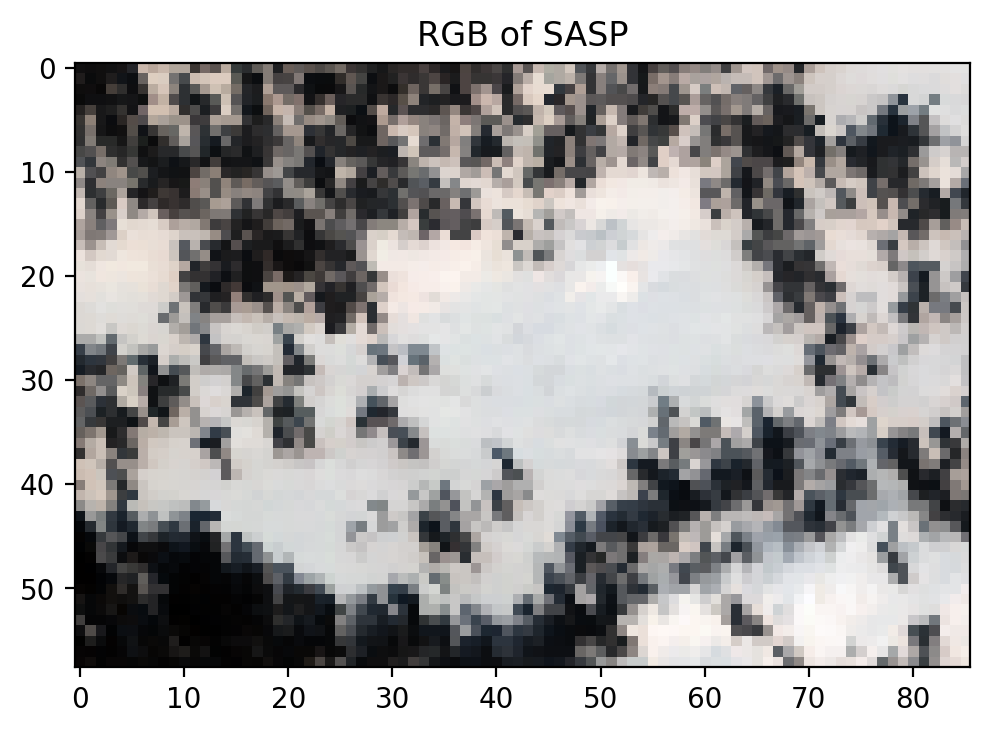
Exercise
Pick the wavelengths of your choice and plot the Swamp Angle Study plot.
Which bands did you pick? Does the image look as expected?
Let’s discuss the result with your neighbour.
Introduction to Spectral Feature Fitting¶
Using the Spectral Feature Fitting method, we can compare the absorption features within the image spectra to a reference spectra in order to identify the presence of a specific material within a given pixel. Here, we will demonstrate this using the ice absorption feature in a snow-covered pixel found within Swamp Angel Study Plot.
Load more data¶
absspec_fname = 'data/h2o_indices.csv'
urllib.request.urlretrieve(
'https://raw.githubusercontent.com/snowex-hackweek/tutorial-data/main/SnowEx-2022/AVIRIS-NG/h2o_indices.csv',
absspec_fname
);
Load the point of interest¶
roi = geopandas.read_file('https://raw.githubusercontent.com/snowex-hackweek/tutorial-data/main/SnowEx-2022/AVIRIS-NG/roi.geojson')
sasp = swamp_angel.explore(
name='Swamp Angel Study Plot',
tiles="Stamen Terrain"
)
roi.explore(
m=sasp,
color='orange',
)
Find the coordinates in pixel space¶
import rasterio
with rasterio.open(SBB_data_file) as sbb_subset:
x, y = sbb_subset.index(roi.geometry.x, roi.geometry.y) # The index methods returns arrays
print(x[0], y[0])
31 54
Show the measured reflectance at this pixel¶
#plot spectrum for a given pixel
my_pixel = image_data[x[0], y[0]]
plt.plot (bands, my_pixel, color='blue')
plt.xlabel('Wavelength (nm)')
plt.ylabel('Reflectance')
plt.show()
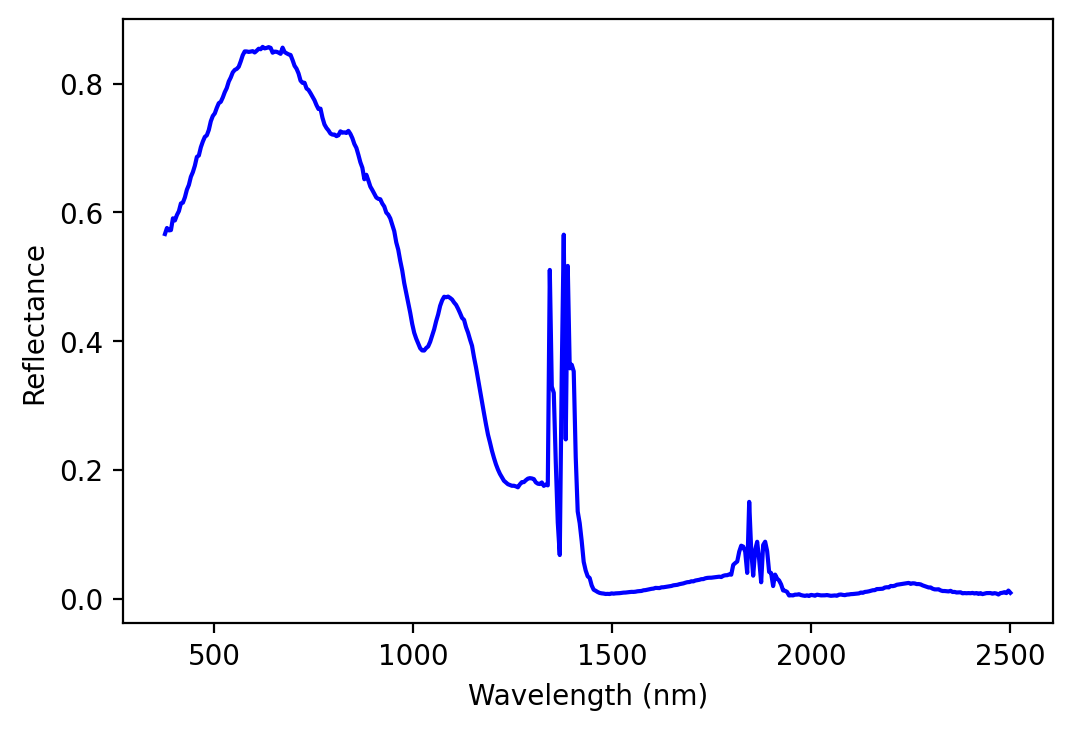
# Read the file into a numpy array
absspec_fullres = np.loadtxt(absspec_fname, delimiter=",", skiprows=1) # Skip the header row
import math
# Extract columns from array
wvl_nm_fullres = absspec_fullres[:, 0] # extract the wavelength column
wvl_cm_fullres = wvl_nm_fullres / 1e9 * 1e2 # convert wavelength from nm to cm
ice_k = absspec_fullres[:, 4] # get k for ice
# Calculate absorption coefficients in cm^-1
ice_abs_fullres = ice_k * math.pi * 4.0 / wvl_cm_fullres
# Plot absorption coefficients
plt.plot(wvl_nm_fullres, ice_abs_fullres, color='darkblue')
plt.xlabel('Wavelength (nm)')
plt.ylabel('Absorption Coefficient ($cm^{-1}$)')
plt.show()
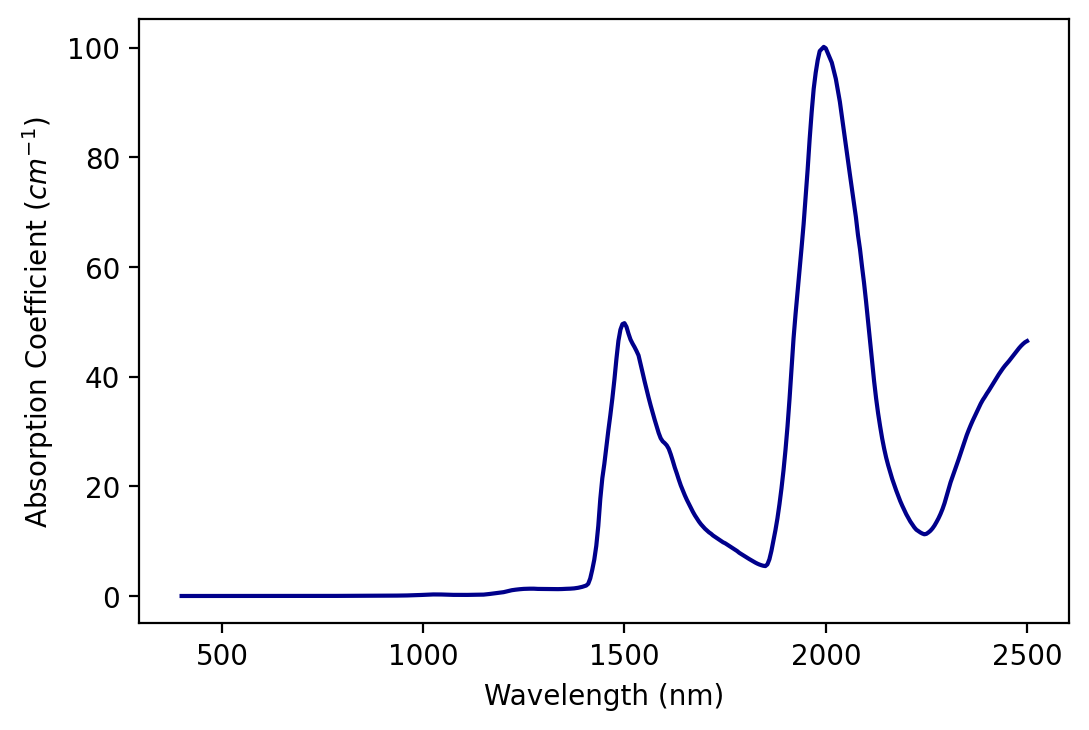
# Calculate e-folding distances in cm
ice_efld_fullres = 1 / ice_abs_fullres
# Plot e-folding distance
plt.plot(wvl_nm_fullres, ice_efld_fullres, color='darkblue')
plt.xlabel('Wavelength (nm)')
plt.ylabel('e-folding distance (cm)')
plt.show()
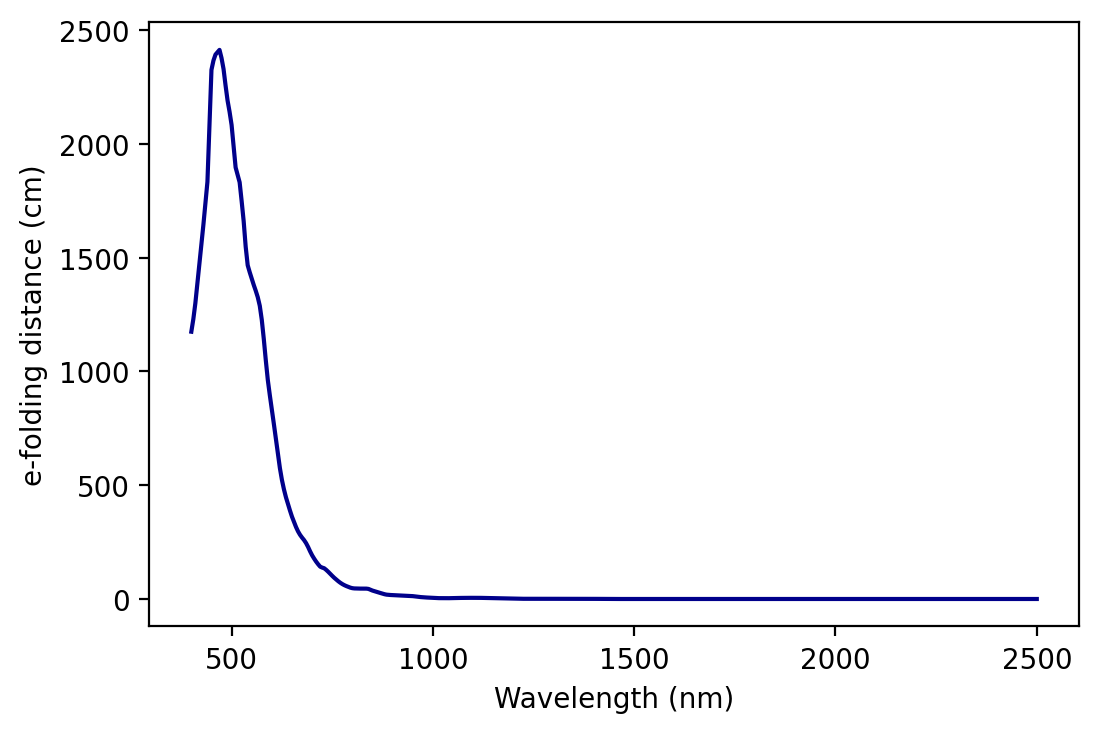
# Plot reflectance for example pixels of each cover type.
plt.plot (bands, image_data[20, 50], color='royalblue') # A bright iceberg pixel
plt.xlabel('Wavelength (nm)')
plt.ylabel('Reflectance')
plt.xlim([400, 2500])
plt.ylim([0, 1.0])
plt.vlines(1028, 0.35, 0.55, color='gray', linestyle='dotted')
plt.show()
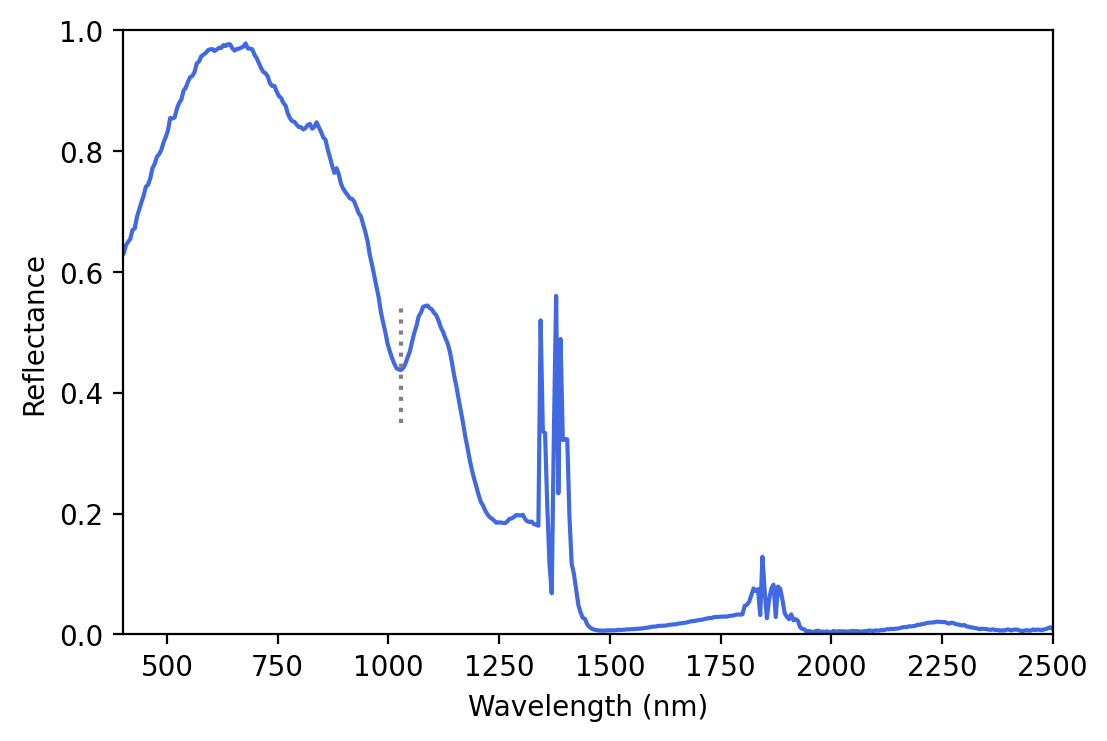
from scipy.interpolate import CubicSpline
# Create CubicSpline functions that use the original absorption spectra wavelengths and values
ice_cs = CubicSpline(wvl_nm_fullres, ice_abs_fullres)
# Interpolate to AVIRIS-NG band center wavelengths
ice_abs_imgres = ice_cs(bands)
# Set the absorption feature wavelength bounds for both abs features
lower_bound = 940
upper_bound = 1095
lower_bound_index = index_for_band(lower_bound)
upper_bound_index = index_for_band(upper_bound)
# Remember: Numpy's upper bound index is excluded. Hence +1
bands_in_feature = bands[lower_bound_index:upper_bound_index + 1]
band_index_in_feature = np.arange(lower_bound_index, upper_bound_index + 1)
# Create an input X value array with wavelengths and ice abs coeffs
xval_array = np.transpose(
np.column_stack((bands_in_feature, ice_abs_imgres[band_index_in_feature])).astype('float32'))
yval_array = my_pixel[band_index_in_feature]
print(xval_array.shape)
print(yval_array.shape)
(2, 32)
(32,)
# Import 'nnls' and set up your x and y arrays
from scipy.optimize import nnls
x_values = np.transpose(
np.array([
np.ones_like(bands_in_feature),
bands_in_feature,
-1 * bands_in_feature,
ice_abs_imgres[band_index_in_feature]
])
)
print(x_values.shape)
y_values = my_pixel[band_index_in_feature]
print(y_values.shape)
(32, 4)
(32,)
# Solve for a, b, d_water, and d_ice using nnls
coeff, resid = nnls(x_values, -np.log(y_values))
print(coeff)
# Look at the estimated water thickness
print("estimated ice thickness = {}".format(round(coeff[3], 3)))
[9.49543765e-01 0.00000000e+00 5.78546826e-04 2.16367229e+00]
estimated ice thickness = 2.164
# Generate your modeled spectral feature from 'fit_water'
nnls_predicted_berg_abs = np.exp(-x_values.dot(coeff[:, np.newaxis]))
# Plot both over your measured spectral feature
plt.figure()
plt.plot(bands_in_feature, my_pixel[band_index_in_feature], color = 'deepskyblue')
plt.plot(bands_in_feature, nnls_predicted_berg_abs, color = 'crimson', linestyle = '--')
plt.legend(['measured ice spectrum',
'\'nnls\' modeled ice spectrum'])
plt.show()
